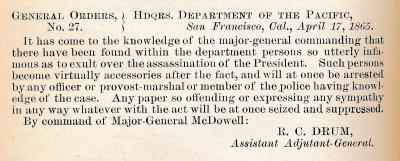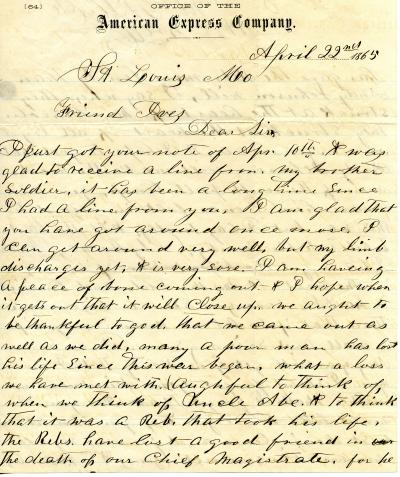Introduction
“News of the Assassination of President Abraham Lincoln” is designed to take place over the course of 3 class sessions. The lesson bridges units on the Civil War and Reconstruction. Through their analysis of primary sources, students learn that citizens expressed a range of reactions to the news of President Lincoln’s assassination.
Students use document analysis sheets to answer the guiding question by writing a claim about each document and supporting it with textual evidence. Working in pairs or groups, students then provide an accurate summary of one of the sources in the form of a brief newscast. Students practice several of Ford’s Theatre’s Podium Points as they polish their “newscast” presentation. Finally, students present their newscast to their peers.
Guiding Questions
- How did people across the country react to Lincoln’s Assassination?
- Did people respond differently in different parts of the country?
- What skills make for a professional presentation?
Objectives
- Students will use the document analysis sheets to answer the guiding question by writing a claim about each document and supporting it with textual evidence.
- Students will provide an accurate summary of one of the sources in the form of a brief newscast.
- Students will practice several of Ford’s Theatre’s Podium Points as they prepare a polished “newscast” presentation of a primary source.
- Students will present their newscast to their peers.
- Students will be able to read and analyze primary source texts.
- Students will cite specific textual evidence to support their analysis of primary source texts.
- Students will gain a better of understanding of the myriad of responses to President Lincoln’s assassination.
- Students will be able to present a speech to a group of peers.
Standards
Procedure
Lesson Activity One: Reactions to Lincoln’s Assassination
Instructor will play “The Assassination of Abraham Lincoln/ PBS America” (
https://www.youtube.com/watch?v=Ncbqfbou-lU) YouTube clip as an introduction to the lesson.
Instructor will present the Focus Activity; a brief reading about the assassination taken from a textbook (secondary source).
- Adjustments, Differentiation
- Use the Think, Pair, Share strategy to have students consider the guiding question, “How did citizens in California react to the news of President Lincoln’s assassination? Did Unionists react differently than Confederate sympathizers? What about African Americans?”
Working independently or in pairs, students will use the document analysis sheets to answer the guiding question by writing a claim about each document and supporting it with textual evidence.
- Adjustments, Differentiation
- The document set can be cut from six to four. Using documents A, B, C, and D provides students with a range of reactions to the assassination.
- Students could be assigned to analyze either documents A and B or C and D. After completing analysis of their assigned documents, they would pair with a student who completed the other set and exchange information.
Using the completed document analysis sheets, students cite at least one example of citizens mourning the death of President Lincoln and at least one example of citizens celebrating his death.
Students then answer the guiding question, “How did citizens in California react to the news of President Lincoln’s assassination?”
- Adjustments, Differentiation
- Ticket Out the Door can be completed as homework if students need additional time to complete their response.
Lesson Activity Two: Newscast Preparation
Review student responses to Ticket Out the Door
Students can volunteer to read their responses. Reponses can be shared in pairs or small groups. If collected during the previous class session, the instructor can display several responses using the overhead projector.
- Adjustments, Differentiation
- Instructor displays the Thrash Out slide from the Presentation/Handouts. Students use sentence frames to explain the position they took in their Ticket Out the Door response. Students first practice with a partner. Then, students show their position by standing in a designated portion of the classroom; one side for those students taking the position that citizens mourned the president’s death and the other side for those taking the position that citizens celebrated the death of the president.
- Each side has three minutes to designate a speaker. Each speaker has two minutes to convince the other side of the validity of their position using textual evidence taken from the primary source documents.
Newscasts
Instructor assigns each student to a group. Each group provides an accurate and brief (approximately 100 word) summary of their assigned source. Summaries will be presented in the next class session in the form of a newscast.
- Review the elements of a newscast. Consider showing a clip of a current news report.
- Review the rubric for the newscast reports with students.
- Adjustments, Differentiation
- The instructor may choose to have students film their newscasts if the technology is available.
Practice Presenting Newscasts (Oratory Skills)
Instructor will play clips from “Ford’s Theatre Oratory Tips and Tricks” (
http://www.fords.org/home/education/school-programs/oratory-tips-and-tricks) showing physical and verbal oratory skills.
Each group will evaluate their newscast for strengths and weaknesses based on the Oratory Tips and Tricks clips. Each group will identify one physical goal and one verbal goal for their newscast.
- Adjustments, Differentiation
- Instructor may ask all students to focus on the goals of diction, volume, posture, and eye contact as these areas are assessed in the newscast rubric.
- Instructor may weight one of the areas more choose different areas of focus depending on the needs of the students.
Lesson Activity Three: Newscast Presentations
Instructor will play clip from “Ford’s Theatre Oratory Tips and Tricks” showing warm and cool feedback.
Students practice presenting their newscast within their small group. Students use the Warm and Cool Feedback sentences frames to help one prepare to deliver their newscasts.
- Adjustments, Differentiation
- Instructor reads a sample newscast and then leads discussion using the tips from the Warm and Cool Feedback clip and the newscast rubric.
Newscast Presentations
- Students present their newscast to their peers.
- Students in the audience practice using the Warm and Cool Feedback sentence frames to write comments to their peers.
- Adjustments, Differentiation
- Newscasts could be presented in small groups instead of to the whole class.
Students complete a written reflection.
- Which activity was the most useful in developing your knowledge of history? (document analysis, Ticket Out the Door, Thrash Out/Take a Stand, newscast summary) Explain why.
- Which activity was the most useful in developing your historical thinking skills? (document analysis, Ticket Out the Door, Thrash Out/Take a Stand, newscast summary) Explain why.
- Which activity was the most useful in developing your literacy skills; reading, writing, listening and speaking? (document analysis, Ticket Out the Door, Thrash Out/Take a Stand, newscast summary, Podium Points, Warm and Cool Feedback) Explain why.
- Adjustments, Differentiation
- The reflection could be completed orally.
Materials
External Resources
-
The Assassination of Abraham Lincoln/ PBS America
-
The California Digital Newspaper Collection- Sacramento Daily Union, Volume 29, Number 4390, 17 April 1865
-
The Black Abolitionist Archive- The Elevator, published in San Francisco, editorial mentions John Wilkes Booth, April 21, 1865
-
Ford’s Theatre - Oratory Tips and Tricks
-
Ford’s Theatre - Podium Points
-
Ford's Theatre - Warm/ Cool Feedback
-
The Black Abolitionist Archive - The Elevator, published in San Francisco, editorial mentions John Wilkes Booth, April 21, 1865

